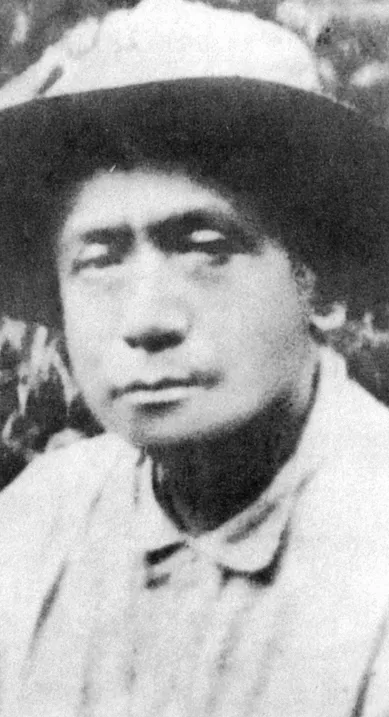On June 27, 1863, Ladislao Diwa, co-founder of the Katipunan, was born in San Roque, Cavite to Mariano Diwa and Cecilia Nocon, who both hailed from San Francisco de Malabon (present day General Trias), Cavite.
Diwa studied under the supervision of Father Francisco Mañalac, who later recommended him at the Colegio de San Juan de Letran as capista. After he finished his Bachelor of Arts degree from Letran, he enrolled in Theology but abandoned the idea of becoming a priest when his father disapproved it. Thus, he opted to become a lawyer so he enrolled Law at the University of Santo Tomas (UST).

|
|
| Ladislao Diwa |
It was during his law studies at UST when he became acquainted with Andres Bonifacio, who was already engaged in distributing propaganda materials. Diwa was already employed as curial de juzgado or oficial de mesa for the district of Quiapo when he joined La Liga Filipina, which Rizal formed on July 3, 1896 and became secretary of the Liga's popular council of Tondo headed by Bonifacio. But the Liga was short-lived. It was dissolved after Rizal was deported to Dapitan. This, however, did not douse the spirit of activism in Diwa, who, upon learning Rizal’s deportation on July 6, proposed the forming of another liberal and secret organization, patterned after the "Black Mask" of Italy, where members belonged to a triumvirate.
Thus, on the night of July 7, 1892 at the house of Deodato Arellano along Azcarraga Street, now Claro M Recto, near Elcano Street in Tondo, he founded with Andres Bonifacio and Teodoro Plata the Katipunan and formed with them its first triangle. With them at the time of the founding were Jose Dizon, Valentin Diaz and Deodato Arellano. Thereafter, they performed a blood compact around a flickering lamp and vowed to carry the aims of the society. Diwa took the name “Balete” and set up his triangle with Roman Basa and Teodoro Gonzales. He was elected fiscal of the Katipunan’s first supreme council in October 1892. In the election in February 1893, he was elected one of its councilors.
When Diwa was transferred to the Justice of the Peace court in Pampanga, he took advantage of it by recruiting members of the Katipunan in Bulacan, Nueva Ecija and Tarlac. Among his well-known recruits was Francisco Makabulos, who later became general after revolution finally erupted.
On August 19, 1896, the Spanish authorities discovered the secret society and as a result, many Filipinos were arrested including Diwa who was picked up in Betis, Bacolor, Pampanga. The discovery left Andres Bonifacio, who was the president of the Katipunan, with no choice but to declare a revolution. Diwa was imprisoned in Bilibid and shared the same cell with Severino de las Alas and Teodoro Plata, his friend who was the clerk of court in Mindoro. On February 1897, Teodoro Plata met his death in Bagumbayan while Diwa was released from prison because of prisoners swap between the Spaniards and the Filipinos.
To elude another arrest, Diwa left for Cavite by disguising himself as fisherman and walked along the seashore, even had to wade under water on his way to San Francisco de Malabon, where he joined the group of General Mariano Trias and earned the rank of a colonel. Diwa was instrumental in the surrender of the Spanish troops under Leopoldo Garcia Peña on May 28, 1898.
After General Aguinaldo was captured in 1901, Diwa surrendered together with Mariano Trias to the Americans.
Like many other revolutionaries who surrendered or captured during the war with America, Diwa took the oath of allegiance to the United States government. Soon after, he was appointed clerk of Court of First Instance for Cavite. He helped establish the Ligaya College in his hometown, where he also taught. He had acquired tracts of land in Tagaytay and Mendez, which he planted with coconut and abaca.
Diwa married twice. The first was with Delisa Dandan from Parañaque with whom he had three children and the second was with Honorata Crescini, with whom he had five children: Edna, Heraclito, Cecilia, Betis, and Alicia.
On March 12, 1930, Diwa died of nephritis at the age of 67. In his honor, the Caridad Elementary School in Cavite was renamed after him in November 1964.
References:
(Agoncillo, Teodoro A. History of the Filipino People. 8th Ed. Quezon City: Garotech, 1990.
Eminent Filipinos. Manila: National Historical Commission, 1970.
Manuel, Arsenio E. Dictionary of Philippine Biography Volume 1. Quezon City: Filipiniana, 1955.
Unpublished interview with Edna and Cecilia Diwa, surviving daughters of Ladislao Diwa.
March 10, 2000. ); All via The Philippine Historical Commission
Photo credit: Philippine Center for Masonic Studies

No comments:
Post a Comment